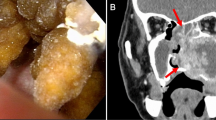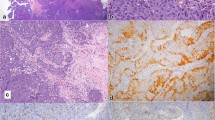Abstract
Low-grade papillary Schneiderian carcinoma is a poorly characterized disease in terms of molecular characteristics and treatment success. Here, we describe a case of poorly differentiated Schneiderian carcinoma with both p53 and p63 positive tumor and overexpression of miR-21that was successfully treated with a single intervention of right jaw hemiresection.
A 61-year-old patient presented with nasal obstruction presented into the clinic. The CT imaging showed the presence of a Schneiderian papilloma in the posterior wall of the right maxillary sinus, with invasion to the right infra-temporal fissure. The histopathological and immunohistopathological revealed that the tumor belonged to the low-grade papillary Schneiderian carcinoma, an aggressive type of head and neck tumor. The decision was made to do a right jaw hemiresection. The resected specimen exhibit epithelial cells that had the growth pattern of inverted papilloma. The CT scanning done during post-operative follow-up found soft tissue in the anterior and lateral maxillary, but the biopsy revealed no presence of tumoral cells, only local inflammation. The immunohistochemistry analysis showed that the resected tumor tissue was p63+, CK7+, p16+, p53+, and Ki67+. The miRNA RT-PCR analysis on the resected tumor versus adjacent normal tissue revealed that miR-21 is overexpressed in tumor tissue, while miR-34a and miR-16 did not show any difference in expression. Our case description shows that even in case of aggressive Schneiderian papilloma molecular profile, the tumor spread is prevented by extending the surgery margins up to jaw hemiresection.



Similar content being viewed by others
References
Nygren A, Kiss K, von Buchwald C, Bilde A. Rate of recurrence and malignant transformation in 88 cases with inverted papilloma between 1998-2008. Acta Otolaryngol. 2016;136(3):333–6.
Lewis JS Jr, Chernock RD, Haynes W, El-Mofty SK. Low-grade papillary schneiderian carcinoma, a unique and deceptively bland malignant neoplasm: report of a case. Am J Surg Pathol. 2015;39(5):714–21.
Jeong HJ, Roh J, Lee BJ, Cho KJ. Low-grade papillary Schneiderian carcinoma: a case report. Head Neck Pathol. 2018;12(1):131–5.
Blumberg JM, Escobar-Stein J, Vining EM, Prasad ML. Low-grade, nonintestinal nonsalivary sinonasal adenocarcinoma associated with an exophytic Schneiderian papilloma: a case report. Int J Surg Pathol. 2015;23(8):662–6.
Carnevale S, Ferrario G, Sovardi F, Benazzo M, Morbini P. Low-grade papillary Schneiderian carcinoma: report of a case with molecular characterization. Head Neck Pathol. 2019. [published online ahead of print, 2019 Aug 31]. Head Neck Pathol. 2019. https://doi.org/10.1007/s12105-019-01067-5
Justice JM, Davis KM, Saenz DA, Lanza DC. Evidence that human papillomavirus causes inverted papilloma is sparse. Int Forum Allergy Rhinol. 2014;4(12):995–1001.
Vorasubin N, Vira D, Suh JD, Bhuta S, Wang MB. Schneiderian papillomas: comparative review of exophytic, oncocytic, and inverted types. Am J Rhinol Allergy. 2013;27(4):287–92.
Barnes L. Schneiderian papillomas and nonsalivary glandular neoplasms of the head and neck. Mod Pathol. 2002;15(3):279–97.
Cheung FM, Lau TW, Cheung LK, Li AS, Chow SK, Lo AW. Schneiderian papillomas and carcinomas: a retrospective study with special reference to p53 and p16 tumor suppressor gene expression and association with HPV. Ear Nose Throat J. 2010;89(10):E5–E12.
But-Hadzic J, Jenko K, Poljak M, Kocjan BJ, Gale N, Strojan P. Sinonasal inverted papilloma associated with squamous cell carcinoma. Radiol Oncol. 2011;45(4):267–72.
Krouse JH. Development of a staging system for inverted papilloma. Laryngoscope. 2000;110(6):965–8.
Xiao-Ting W, Peng L, Xiu-Qing W, Hai-Bo W, Wen-Hui P, Bing L, et al. Factors affecting recurrence of sinonasal inverted papilloma. Eur Arch Otorhinolaryngol. 2013;270(4):1349–53.
Yildirim V, Pausch NC, Halama D, Lubbers HT, Yildirim A. Is radical surgery of an inverted papilloma of the maxillary sinus obsolete? A case report. J Med Case Rep. 2016;10(1):341.
Cannady SB, Batra PS, Sautter NB, Roh HJ, Citardi MJ. New staging system for sinonasal inverted papilloma in the endoscopic era. Laryngoscope. 2007;117(7):1283–7.
Rocco JW, Leong C-O, Kuperwasser N, DeYoung MP, Ellisen LW. p63 mediates survival in squamous cell carcinoma by suppression of p73-dependent apoptosis. Cancer Cell. 2006;9(1):45–56.
Boldrup L, Coates PJ, Wahlgren M, Laurell G, Nylander K. Subsite-based alterations in miR-21, miR-125b, and miR-203 in squamous cell carcinoma of the oral cavity and correlation to important target proteins. J Carcinog. 2012;11:18.
Lakshmanachetty S, Balaiya V, High WA, Koster MI. Loss of TP63 promotes the metastasis of head and neck squamous cell carcinoma by activating MAPK and STAT3 signaling. Mol Cancer Res MCR. 2019;17(6):1279–93.
Funding
The research was funded by the PCD project entitled: “Stem cell involvement in oncological, oral and maxillofacial pathology” and by the project PNCDI III 2015-2020 “Increasing the performance of scientific research and technology transfer in translational medicine through the formation of a new generation of young researchers”—ECHITAS, no.29PFE/18.10.2018.
Author information
Authors and Affiliations
Corresponding author
Ethics declarations
Conflict of Interest
The authors declare that they have no conflict of interest.
Additional information
Publisher’s Note
Springer Nature remains neutral with regard to jurisdictional claims in published maps and institutional affiliations.
This article is part of the Topical Collection on Medicine
Rights and permissions
About this article
Cite this article
Urcan, D.M., Zimta, AA., Onisor, F. et al. Novel Insights into the Characteristics of Poorly Differentiated Schneiderian Carcinoma: a Case Report. SN Compr. Clin. Med. 2, 985–991 (2020). https://doi.org/10.1007/s42399-020-00332-x
Accepted:
Published:
Issue Date:
DOI: https://doi.org/10.1007/s42399-020-00332-x




